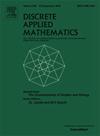An approximate dynamic programming approach for multi-stage stochastic lot-sizing under a Decision–Hazard–Decision information structure
IF 1
3区 数学
Q3 MATHEMATICS, APPLIED
引用次数: 0
Abstract
This work studies a combinatorial optimization problem encountered in industrial production planning: the single-item multi-resource lot-sizing problem with inventory bounds and lost sales. The demand to be satisfied by the production plan is subject to uncertainty and only probabilistically known. We consider a multi-stage decision process with a Decision–Hazard–Decision information structure in which decisions are made at each stage both before and after the uncertainty is revealed. Such a setting has not yet been studied for stochastic lot-sizing problems, and the resulting problem is modeled as a multi-stage stochastic integer program. We propose a solution approach based on an approximate stochastic dynamic programming algorithm. It relies on a decomposition of the problem into single-stage sub-problems and on the estimation at each stage of the expected future costs. Due to the Decision–Hazard–Decision information structure, each nested single-stage sub-problem is itself a two-stage stochastic integer program. We therefore introduce a Benders decomposition scheme to reduce the computational effort required to solve each nested sub-problem, and present a special-purpose polynomial-time algorithm to efficiently solve the single-scenario second-stage sub-problems involved in the Benders decomposition. The results of extensive simulation experiments carried out on large-size randomly generated instances are reported. They demonstrate the practical benefit, in terms of the actual production cost, of using the proposed approach as compared to a naive deterministic optimization approach based on the expected demand.
决策-风险-决策信息结构下多阶段随机批量问题的近似动态规划方法
本文研究了工业生产计划中遇到的一个组合优化问题:具有库存边界和销售损失的单品多资源批量问题。生产计划所要满足的需求是不确定的,只是概率已知的。我们考虑了一个具有决策-风险-决策信息结构的多阶段决策过程,其中每个阶段的决策都在不确定性暴露之前和之后进行。这种设置尚未对随机批量问题进行研究,所得到的问题被建模为一个多阶段随机整数规划。我们提出了一种基于近似随机动态规划算法的求解方法。它依赖于将问题分解为单阶段子问题,以及在每个阶段对预期未来成本的估计。由于决策-风险-决策的信息结构,每个嵌套的单阶段子问题本身就是一个两阶段随机整数规划。因此,我们引入了一种Benders分解方案来减少求解每个嵌套子问题所需的计算量,并提出了一种专用多项式时间算法来有效地求解Benders分解中涉及的单场景第二阶段子问题。报告了在大尺寸随机生成实例上进行的大量仿真实验的结果。就实际生产成本而言,与基于预期需求的幼稚确定性优化方法相比,它们证明了使用所提出的方法的实际效益。
本文章由计算机程序翻译,如有差异,请以英文原文为准。
求助全文
约1分钟内获得全文
求助全文
来源期刊

Discrete Applied Mathematics
数学-应用数学
CiteScore
2.30
自引率
9.10%
发文量
422
审稿时长
4.5 months
期刊介绍:
The aim of Discrete Applied Mathematics is to bring together research papers in different areas of algorithmic and applicable discrete mathematics as well as applications of combinatorial mathematics to informatics and various areas of science and technology. Contributions presented to the journal can be research papers, short notes, surveys, and possibly research problems. The "Communications" section will be devoted to the fastest possible publication of recent research results that are checked and recommended for publication by a member of the Editorial Board. The journal will also publish a limited number of book announcements as well as proceedings of conferences. These proceedings will be fully refereed and adhere to the normal standards of the journal.
Potential authors are advised to view the journal and the open calls-for-papers of special issues before submitting their manuscripts. Only high-quality, original work that is within the scope of the journal or the targeted special issue will be considered.
 求助内容:
求助内容: 应助结果提醒方式:
应助结果提醒方式:


